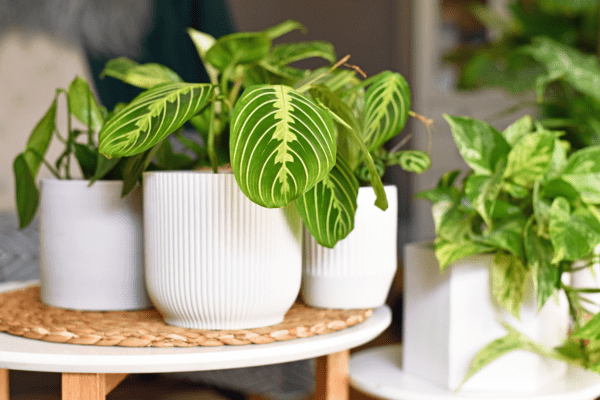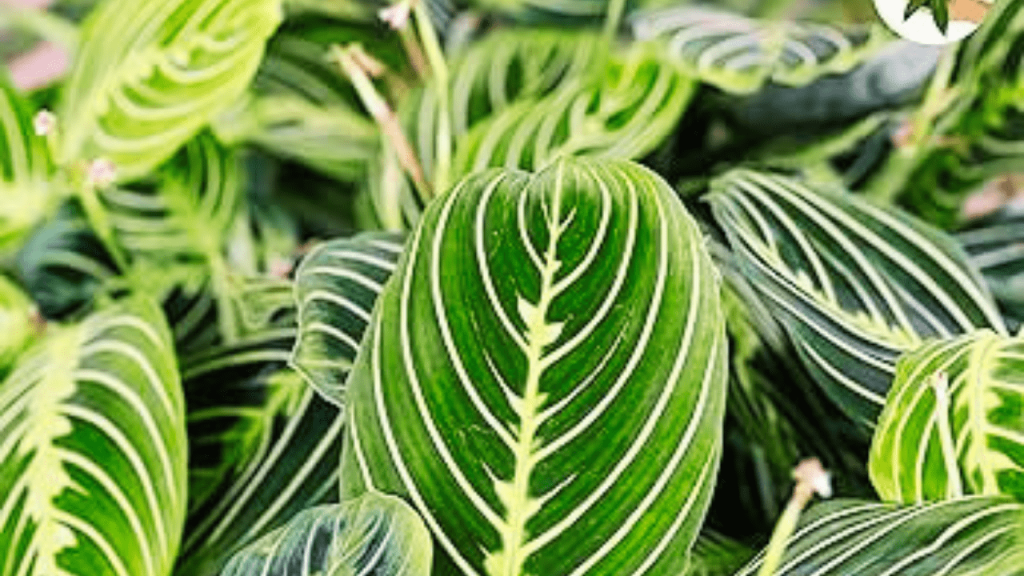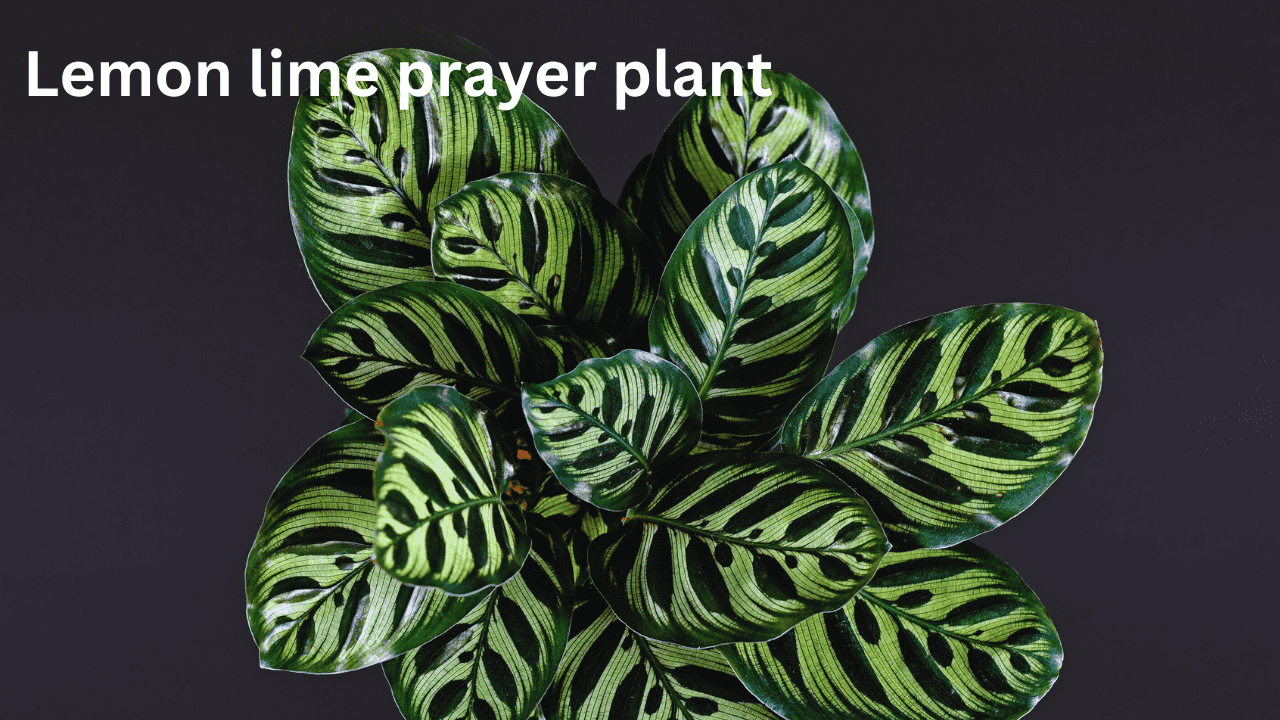Lemon Lime Prayer Plant
Lemon Lime Prayer Plant, scientifically named Maranta leuconeura ‘Lemon Lime,’ is a lovely and popular indoor plant. It comes from the tropical parts of South America and belongs to the Marantaceae family. What makes this plant special is its eye-catching leaves with green and yellow colors in cool patterns. This plant not only adds beauty to your indoor space but also has a unique habit – at night, its leaves fold up, looking like praying hands. That’s why it’s called a Prayer Plant
Table of Contents
Table of Content
| Common Name | Prayer plant |
| Botanical Name | Maranta leuconeura |
| Family | Marantaceae |
| Plant Type | Herbaceous, perennial |
| Mature Size | 6–12 in. tall, 6–12 in. wide |
| Sun Exposure | Partial, shade |
| Soil Type | Moist but well-drained |
| Soil pH | Neutral, acidic |
| Bloom Time | Spring |
| Flower Color | White |
| Hardiness Zones | 11-12 (USDA) |
| Native Area | South America |
Why is it Called a Prayer Plant?
The Maranta Lemon Lime Plant gets its name because of how its leaves move. As the day turns into night, its leaves gently fold up, resembling hands in prayer. This is called nyctinasty, and it helps the plant save water at night and get more sunlight in the morning. This interesting feature has fascinated plant lovers for a long time, making the lemon and lime Plant a special and meaningful addition to homes all over the world.
Why is Maranta Lemon Lime Popular Among Houseplant Enthusiasts?

Houseplant lovers adore the Lemon Lime Prayer Plant for its striking appearance, low maintenance, and air-purifying qualities. Its vivid green and yellow leaves make it a star in any room, and its prayer-like leaf movements add an element of fascination.
Lemon Lime Prayer Plant Care Guide
Light: Indirect, bright to moderate light. Avoid direct sun.
Temperature: 65-75°F (18-24°C) during the day, no lower than 60°F (15°C) at night.
Humidity: High humidity (around 50-60% or more). Use a humidifier or pebble tray.
Watering: Keep soil consistently moist but not soggy. Water the plant when the upper inch of the soil becomes dry.
Soil: Well-draining potting mix rich in organic matter.
Container: Use a pot with drainage holes to prevent waterlogging.
Fertilization: Fertilize every 4-6 weeks with a balanced liquid fertilizer during the growing season.
Pruning: Trim leggy or damaged growth to encourage bushiness.
Repotting: Repot every 2 to 3 years or whenever the plant becomes too big for its current pot.
Propagation: We can use stem cuttings, division and rhizome division method for the propagation of lemon lime prayer plant.
Pests: Watch for spider mites, mealybugs, and aphids. Treat promptly if detected.
Toxicity: Non-toxic to humans and pets but may cause mild skin irritation.
Remember that these care guidelines are general recommendations and may need to be adjusted based on your specific growing conditions and the plant’s response. Regularly check your Lemon Lime Plant for signs of stress or overwatering, and adjust care as needed.
For proper care and maintance of lemon lime prayer plant. Click here.
Scientific Name of Maranta Leuconeura Lime
The Lemon Lime Plant belongs to the Maranta genus within the Marantaceae family. Its full scientific name is Maranta leuconeura ‘Lemon Lime.’ This specific variety is treasured for its eye-catching, lemony-lime green leaves, making it a sought-after choice among plant lovers looking to infuse vibrant and dynamic colors into their indoor spaces. Whether you’re a seasoned plant enthusiast or a beginner, the Lemon Lime Prayer Plant is a fantastic addition that combines aesthetics with a touch of natural wonder.”
Native Habitat
The Lemon Lime Prayer Plant comes from the rainforests in Central and South America. It really likes living on the ground in the shady parts of the forest with sunlight peeking through the trees. There, it’s warm and humid, which is perfect for the plant. If we want it to be happy at home, we should try to copy these conditions by keeping it in a place with some humidity and not too much direct sunlight
Varieties of lemon-lime prayer plant
Certainly! Here are different types of Lemon Lime Prayer Plants:
- Lemon Lime Prayer Plant
- Marisela Prayer Plant
- Hannii Prayer Plant
- Erythroneura Prayer Plant
- Kerchoveana Prayer Plant
- Kim Prayer Plant
- Fascinator Prayer Plant

Each kind has its unique leaf designs and colours, so you can pick the one that matches what you like and how your home looks.
Lemon Lime Prayer Plant Characteristics
Here are some key characteristics of the Maranta Green Prayer Plant:
Leaf Patterns
The Lemon Lime maranta Plant is known for its striking and intricate leaf patterns. These patterns often resemble veins, adding to its visual appeal.
Leaf Colors
The leaves of this plant are predominantly green with vibrant lemon-lime or yellowish stripes, giving it a unique and eye-catching appearance.
Leaf Movement
One of its most fascinating features is its ability to fold its leaves upwards in the evening, resembling hands in prayer. This natural leaf movement is captivating to observe.
Size
Typically, maranta leuconeura lime grows to a moderate size, making it suitable for indoor spaces. It can reach a height of around 6 to 12 inches.
Growth Habit
This plant has a clumping growth habit, producing multiple stems and leaves from its base.
Low Maintenance
It is considered a low-maintenance houseplant, making it suitable for beginners. It doesn’t require constant attention and can thrive with primary care.
Air Purification
Like many indoor plants, the lemon maranta has air-purifying qualities, helping improve your home’s air quality by removing toxins.
Tropical Origin
Originating from the tropical rainforests of Brazil, it thrives in warm and humid conditions, making it ideal for indoor cultivation.
Decorative Use
Its vibrant foliage makes it an excellent home decorative element, adding a touch of nature and colour to various settings.
These characteristics make the lemon-lime calethea a beloved choice among houseplant enthusiasts for its aesthetic appeal and ease of care.
Conclusion
This guide gives you essential information about the excellent maranta lemon-lime. You now know where it comes from, how to take care of it, and what makes it unique. This plant is beautiful and easy to care for, making your home more excellent and your air cleaner. So, enjoy having this lovely plant in your home and become a lemon Maranta plant fan!
FAQ’s(Frequently Asked Questions)
What is a Lemon Lime Prayer Plant?
The lemon-lime maranta, scientifically named Maranta leuconeura ‘Lemon Lime,’ is a tropical houseplant recognized for its vibrant green and yellow leaves and intriguing leaf motions.
What are the care requirements for a Lemon Lime Prayer Plant?
Give the lime prayer plant indirect, bright to moderate light, keep the temperature between 65-75°F (18-24°C), and maintain moist but not waterlogged soil in a well-draining pot with proper drainage.
Why is it called a “Prayer Plant”?
It’s called a “Prayer Plant” because its leaves fold upward at night, resembling hands in prayer. This natural leaf movement is fascinating to observe.
Is the Lemon Lime Prayer Plant harmful to pets?
This maranta lemon plant is considered mildly toxic to cats(Maranta Toxic to Cats) and dogs. It’s best to keep it out of reach of pets or choose pet-friendly plants if you have animals in your home.
Is the Lemon Lime Prayer Plant a good air purifier?
Like many indoor plants, the maranta lemon plant has air-purifying qualities that help improve indoor air quality by removing toxins.
Do lemon lime prayer plants sleep?
The Lemon Lime Prayer Plant moves its leaves when it gets dark, but it doesn’t really sleep like animals do.
Is the Lemon Lime plant suitable for indoors?
Yes, the Philodendron Lemon Lime is an indoor plant. Its bright chartreuse leaves shine in the light, adding a burst of color. You can mix it with colors like purple for a balanced look.
How many years does a lemon lime prayer plant live?
It grows slowly and can live for about 5 years in good conditions. This plant likes bright or indirect sunlight and can be in most well-lit rooms. It performs optimally in soil that ranges from average to moist conditions.
Do prayer plants enjoy rain?
Yes, they do well if you give them what they like. Prayer plants are from the tropics, so they’re happiest in an environment that’s similar. They thrive with humidity, indirect light, clean leaves, and water that’s filtered or from rain.
Why is my prayer plant sad?
If the leaves are curling, it might be because you’re giving it too much or too little water. Make sure to water it regularly when some of the soil is dry. If the soil dries out completely, the leaves might get floppy, droopy, and brown.


Nice . Great information.
Thanks.
Hello! I simply would like to offer you a huge thumbs up for the great information you have right here on this post. I will be coming back to your blog for more soon.
Thank You.